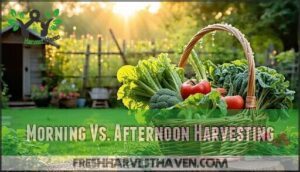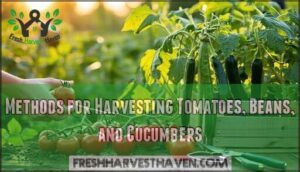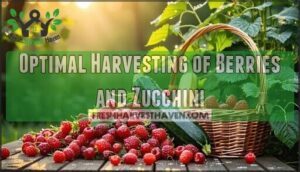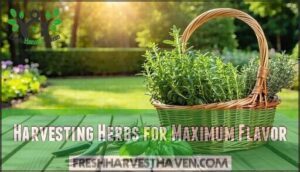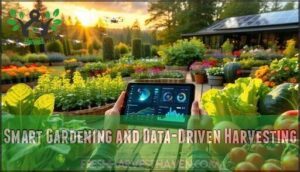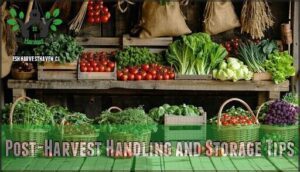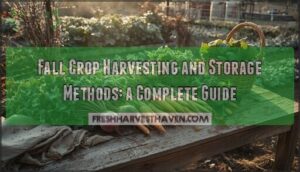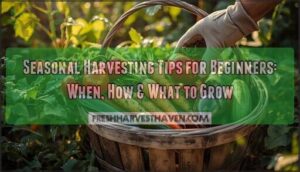This site is supported by our readers. We may earn a commission, at no cost to you, if you purchase through links.
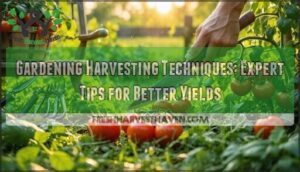
The difference between a thriving plant that keeps producing and one that limps through the season often comes down to how you remove what you’ve grown. Sharp tools matter, timing changes everything, and a few smart techniques can double your yields while keeping plants healthier.
When you understand what happens at the cellular level during harvest, you’ll stop treating your garden like a grocery store and start working with plant biology instead of against it.
Table Of Contents
Key Takeaways
- Sharp, clean tools and precise cutting techniques prevent disease spread and keep plants producing longer, while dull blades crush tissue and create pathogen entry points that can destroy weeks of growth.
- Harvesting in the morning maximizes moisture content, flavor, and shelf life for most crops, with produce retaining up to 12% more water and staying fresh an extra day or two compared to afternoon picking.
- Never harvest wet plants—moisture on leaves and stems creates ideal conditions for fungal diseases and bacteria that spread rapidly through your garden and contaminate your entire yield.
- Remove only what’s ripe and use sequential harvesting for crops like tomatoes, beans, and herbs, which triggers plant regeneration and extends your harvest window by weeks instead of exhausting the plant in one pull.
Essential Tools and Preparation for Harvesting
Before you harvest a single tomato or snip that first sprig of basil, you need the right tools and a solid game plan. Sharp, clean equipment isn’t just about making the job easier—it’s your first line of defense against spreading disease and damaging your plants.
Let’s break down what you need to know about tools, timing, and prep work so you can optimize every harvest.
Choosing and Maintaining Clean, Sharp Tools
Your harvesting tools are the gatekeepers between a thriving garden and one that falls victim to disease, so keeping them clean and sharp isn’t just good practice—it’s your first line of defense. Dull blades crush plant tissue instead of making clean cuts, creating entry points for pathogens.
After each use, wipe your garden shears with rubbing alcohol or a 10% bleach solution for proper tool sanitation, and use a sharpener regularly to maintain blade edges that slice through stems like butter.
Preparing Garden Beds for Harvest
Before you can pull the harvest rewards from your garden, the bed itself needs to be in prime condition—clear pathways, manageable weeds, and soil that drains well enough to keep your knees dry while you work.
Smart bed layout and crop rotation prevent disease buildup, while proper garden sanitation—removing dead foliage and spent plants—stops pathogens before they sabotage your harvest planning.
A little garden maintenance now means you’ll actually enjoy the harvesting techniques that deliver those beautiful yields.
Timing Your Harvest by Plant Type
Each plant ripens on its own schedule, so knowing whether you’re dealing with a heat-loving tomato or a cool-season lettuce can mean the difference between peak flavor and a mediocre harvest. Here’s how to time your harvesting techniques:
- Tomatoes and beans: Harvest when firm and fully colored, usually 60-85 days after planting
- Cucumbers and zucchini: Pick at 6-8 inches for ideal texture
- Herbs: Cut before flowering for maximum flavor
- Lettuce: Harvest in cool morning hours during growth stages
Crop rotation and seasonal planning help you track plant maturity patterns season after season.
Understanding Plant Hardiness Zones
Once you’ve nailed the timing, you’ll want to know what actually survives in your region. Plant Hardiness Zones—especially the USDA Hardiness Zone map—divide the country into 13 zones based on minimum winter temperatures, helping you choose plants that’ll thrive through cold snaps and climate shifts. Understanding the hardiness zone map is essential for making informed decisions about plant selection and care.
| Zone | Temperature Range (°F) | Example Regions |
|---|---|---|
| 5a | -20 to -15 | Minnesota, Wisconsin |
| 7b | 5 to 10 | Oklahoma, Virginia |
| 9a | 20 to 25 | Southern California, Texas Coast |
| 10b | 35 to 40 | Southern Florida, Hawaii |
Understanding plant hardiness zones transforms your seasonal gardening tips from guesswork into strategy, accounting for regional gardening realities and microclimates around buildings or slopes.
Best Techniques for Harvesting Fruits and Vegetables
When you understand the right technique for each crop, you’re not just picking produce—you’re maximizing flavor, extending your harvest window, and keeping your plants productive for weeks longer. The difference between a mediocre harvest and an abundant one often comes down to timing and method.
Here’s how to harvest your most common garden crops like a pro.
Morning Vs. Afternoon Harvesting
When does harvest timing make or break crop quality? Morning harvests win for most vegetables—cooler temperatures mean your produce holds more water, stays crisper, and lasts longer in storage. Morning-picked leafy greens and herbs retain up to 12% more moisture and resist wilting for an extra day or two.
But here’s the twist: if you’re harvesting forages like alfalfa, afternoon heat actually boosts protein and energy content by up to 15%. Your harvest strategies should match your crop—prioritize dawn for maximizing flavor and nutrition in tomatoes, beans, cucumbers, zucchini, and herbs when daytime temperatures would sap moisture levels fast.
Harvest forages like alfalfa in the afternoon heat to boost protein and energy content by up to 15%
Understanding proper harvesting techniques is vital for achieving peak quality in various vegetables.
Methods for Harvesting Tomatoes, Beans, and Cucumbers
Twist the stem gently, never yank—that’s the golden rule for keeping your tomato, bean, and cucumber plants productive all season long. For harvesting tomatoes and beans, clip stems with pruners to prevent vine damage that invites disease. When harvesting cucumbers and zucchini, cut—don’t pull—at the base where fruit meets stem.
Optimizing harvest time matters: harvest timing directly affects fruit quality and garden planning. Proper soil temperature and crop rotation reduce stress on plants, preventing plant diseases while harvesting herbs and vegetables consistently through the season.
Optimal Harvesting of Berries and Zucchini
Berries bruise at the slightest squeeze, and zucchini can hide softball-sized surprises overnight—both demand quick reflexes and a gentle hand. Berry picking requires daily checks during peak ripeness, while zucchini care means harvesting every other day before fruits exceed 6-8 inches. Crop monitoring prevents oversized produce that drains plant energy.
- Check berry color and easy release from stems—ripe fruit drops willingly
- Cut zucchini stems with clean shears to prevent disease spread
- Harvest in early morning when fruit ripening peaks for supreme flavor
Harvesting Herbs for Maximum Flavor
Herbs release their most potent essential oils in that ideal window between morning dew and midday heat—catch them then, and your kitchen will taste the difference. Snip stems when leaves are fully dry but before the sun wilts them, using sharp pruning techniques that won’t crush delicate tissue. Harvest no more than one-third of each plant to maintain plant health while maximizing flavor enhancement.
| Herb Type | Best Harvest Timing | Preservation Method |
|---|---|---|
| Basil, Mint | Morning after dew dries | Hang for herb drying or freeze |
| Rosemary, Thyme | Late morning | Air dry for aromatic preservation |
| Cilantro, Parsley | Early morning | Refrigerate stems in water |
Preventing Disease and Maximizing Plant Health
Your harvest doesn’t end when you pull the last tomato—what you do next determines whether your plants thrive or struggle with disease. Smart post-harvest care protects your garden from fungal infections, pest damage, and unnecessary stress that can wreck next season’s yields.
Here’s how to keep your plants healthy and productive after every harvest.
Avoiding Wet Plant Harvesting
When you reach for damp leaves or dewy stems, you’re rolling out the welcome mat for bacteria and fungi that can wipe out weeks of hard work in your garden. Moisture content on plant surfaces creates the perfect breeding ground for fungal diseases that spread like wildfire through your harvest.
Wait until morning dew evaporates completely before harvesting—your plants will thank you. This simple shift in harvest timing protects plant health and keeps your yield safe from avoidable moisture-related problems.
Using Proper Pruning and Deadheading Methods
Sharp tools aren’t just nice to have—they’re your first line of defense against inviting disease into your garden. Clean cuts heal faster and seal out pathogens that turn small wounds into major problems. Master these pruning techniques and deadheading strategies to take control:
- Prune timing matters—tackle spring-flowering shrubs right after blooms fade
- Remove spent flowers on perennials to redirect energy and boost production
- Skip deadheading on plants you’re growing for decorative fruits or seed pods
- Clean your gardening tools between cuts to stop disease spread cold
- Use plant shaping methods that promote airflow and reduce fungal risks
Plant care isn’t guesswork—it’s calculated action that pays off in stronger, healthier growth.
Managing Moisture and Fungal Disease Risks
Fungal control starts with understanding moisture. Gardens using soil moisture retention methods can save 28% water while increasing yields by 22%. You’re not just watering; you’re managing an ecosystem where fungal growth thrives at water activity levels between 0.95 and 0.99.
Mulching cuts soil evaporation by 60%, and drip irrigation operates at 90% efficiency compared to sprinklers, dramatically reducing surface wetness that invites disease.
Harvest timing isn’t optional—delayed harvesting by just 10 to 20 days substantially increases fungal infections and mycotoxin contamination in crops.
Post-Harvest Plant Care and Maintenance
Once you’ve pulled the last tomato or snipped the final herbs, your plants still need attention to bounce back stronger for the next harvest cycle. Post-harvest plant care sets the stage for better crop yields and healthier soil.
- Remove diseased foliage immediately to prevent garden sanitation issues
- Replenish soil with compost or organic matter after harvesting
- Rotate crops strategically to interrupt pest cycles and restore nutrients
This maintenance work directly fosters plant regeneration and long-term garden health.
Smart Gardening and Data-Driven Harvesting
You’re about to break free from guesswork and take full control of your harvest timing. Modern technology puts precision tools in your hands, from meters that measure sweetness to systems that predict the perfect picking window.
Let’s explore how data-driven strategies help you boost yields, conserve resources, and cut losses before they happen.
Using Brix Meters and Ripeness Detectors
If you want to take the guesswork out of picking produce at peak sweetness, a Brix meter can become your secret weapon in the garden. This handheld tool measures sugar content in fruits and vegetables, giving you hard data on ripeness instead of relying on color or feel alone.
When you’re harvesting tomatoes or melons, a quick reading tells you exactly when flavor peaks, which also extends shelf life and improves overall fruit quality through precise harvest optimization.
Leveraging Predictive Models for Harvest Timing
Beyond measuring sugar, you can utilize predictive analytics and machine learning to master harvest scheduling with near-perfect precision.
These data-driven farming models analyze historical prices, seasonal dynamics, and plant biology to pinpoint your most profitable harvest windows—some systems hit 99% accuracy for crop yield forecasting.
You’re no longer guessing when to pull crops; you’re commanding your garden with science-backed harvesting techniques that optimize both quality and profit.
Water and Resource Optimization Strategies
Smart irrigation isn’t just about watering plants—it’s about reclaiming thousands of gallons while your garden thrives on precisely what it needs, nothing more. Here’s how to command your resources:
- Install soil moisture sensors to eliminate guesswork and trigger irrigation systems only when your soil demands it
- Capture rainwater harvesting to slash municipal water dependence and buffer against drought management challenges
- Improve drainage patterns to prevent waterlogging that suffocates roots and destroys soil health
- Apply mulch layers to lock in moisture, slash evaporation, and strengthen your watering techniques naturally
Reducing Postharvest Losses With Technology
AI Solutions are slashing postharvest losses by up to 30% in pilot programs, transforming how you protect your harvest. IoT Sensors monitor temperature and humidity in Smart Storage, preventing spoilage before it starts. Predictive Analytics pinpoint ideal harvest timing with 99% accuracy, while Robotic Harvesting reduces damaged produce by 18%.
These technologies master understanding respiration rates and proper storage techniques, preserving garden produce far beyond traditional methods—so you keep more of what you grow.
Post-Harvest Handling and Storage Tips
Once you’ve harvested your crops at peak ripeness, what you do next makes all the difference. Proper management, storage, and processing protect the flavor, nutrition, and shelf life you worked so hard to cultivate.
Let’s break down four essential practices that’ll help you optimize every single harvest from your garden.
Proper Storage for Flavor and Nutrition Retention
The moment you pull a crisp cucumber or sun-warmed tomato from the vine, the clock starts ticking on its peak flavor and nutritional value. Understanding respiration rates is your secret weapon—leafy greens breathe fast and need immediate cooler management, while root vegetables slow down in root cellars.
Control moisture with proper storage techniques: tomatoes hate refrigeration, but vacuum sealing extends freezer storage for blanched beans.
Master these fundamentals before preserving garden produce through food dehydration.
Preserving and Processing Garden Produce
Transform your garden bounty into shelf-stable treasures through freezing, canning, fermenting, and dehydrating—proven methods that lock in nutrients and flavors for months to come.
Canning methods work brilliantly for tomatoes and pickles, while fermentation techniques turn cabbage into probiotic-rich sauerkraut.
Food dehydration concentrates flavors in herbs and peppers, and freeze drying preserves berries with minimal texture loss.
These gardening tips turn your vegetable gardening success into year-round preserving victories.
Composting Garden Waste for Soil Health
Your garden scraps aren’t waste—they’re raw material for building the kind of rich, living soil that makes plants thrive without synthetic fertilizers. Composting transforms plant debris into organic amendments through nutrient cycling, feeding soil microbes that drive soil health. Proper composting balances browns and greens for effective waste reduction and carbon sequestration during garden maintenance and soil preparation.
- Reclaim control over your soil’s destiny by composting every scrap
- Build unshakable confidence watching kitchen waste transform into black gold
- Break free from expensive fertilizers with your own nutrient powerhouse
- Master the art of compost materials layering for faster decomposition
- Command nature’s recycling system to fuel explosive plant growth
Safe Handling and Gardening Hygiene Practices
Most gardeners never think of their tools as disease vectors, but every time you touch a plant with contaminated hands or dirty shears, you’re rolling the dice with your entire harvest. Tool sanitizing between cuts stops pathogens dead—wipe blades with rubbing alcohol or bleach solution.
Gloves safety matters: change them when moving between diseased and healthy plants. Hand washing before and after gardening tool usage protects both you and your crops, essential gardening tips for beginners mastering garden hygiene for bulletproof plant health and pest and disease control.
Frequently Asked Questions (FAQs)
How do you know when root vegetables are ready?
Funny how what’s buried reveals itself best by staying hidden a bit longer. Check root vegetable maturity signs by gently brushing soil away from plant roots—you’ll see size and color without full harvest.
Soil moisture levels affect timing too; drier conditions signal readiness.
Whats the best way to harvest leafy greens?
Cut individual outer leaves with sharp, clean scissors or snap them off at the base, working from the outside in. This method extends your harvest window and keeps plants producing fresh Leafy Green Care throughout the season.
Can you harvest the same plant multiple times?
Absolutely—many crops thrive with sequential picking, which triggers plant regeneration and boosts fruit production. Tomatoes, beans, zucchini, berries, and herbs all benefit from multiple harvests.
This method optimizes yield optimization while smart pruning and crop rotation keep your plants productive all season long.
How do you store freshly harvested garlic and onions?
After harvesting, cure garlic and onions by leaving them in a warm, dry, well-ventilated space for two to three weeks until the outer skins turn papery and necks dry completely before storage.
What should you do with overripe or damaged produce?
Overripe tomatoes turn into rich sauces, while bruised berries work perfectly for jams—Food Waste Reduction starts in your garden.
Toss truly rotten produce into your compost pile to boost Compost Creation and feed next season’s soil instead of the landfill.
Conclusion
Here’s the twist most gardeners miss: the plants you baby all season don’t need gentler treatment at harvest—they need precision. Your gardening harvesting techniques determine whether those vines keep pumping out fruit or shut down production to heal damage you didn’t mean to cause.
Master the cut, respect the timing, and treat each harvest like the surgical procedure it actually is. Your garden won’t just survive the season—it’ll thrive through it, rewarding your attention with baskets that overflow instead of plants that merely endure.
- https://www.thrivelot.com/resources/how-harvest-timing-impacts-garden-yield-and-flavor
- https://pmc.ncbi.nlm.nih.gov/articles/PMC11988806/
- https://www.agronomyjournals.com/article/view/1636/S-7-9-100
- https://fieldking160052185.wordpress.com/2025/03/24/how-does-agricultural-machinery-impact-crop-yields/
- https://earth911.com/home-garden/harvesting-data-how-to-maximize-your-gardens-potential-with-green-tech/

